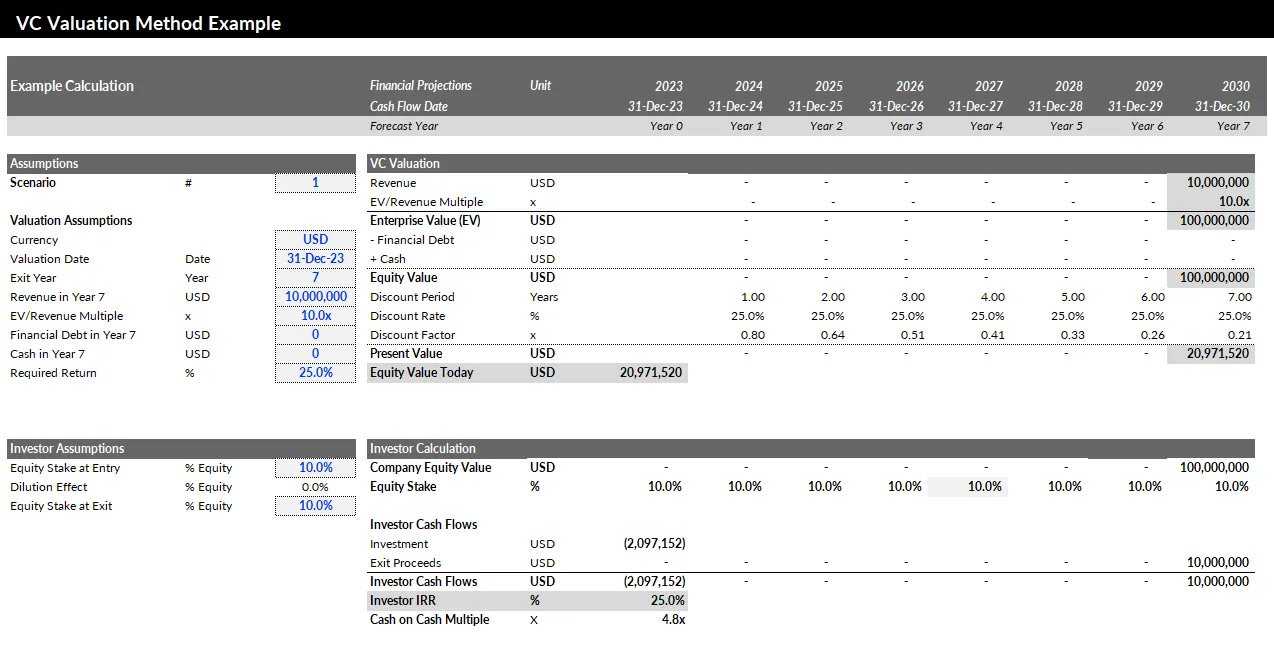How VCs Value Startups: The VC Method + Excel Template
Learn the Venture Capital Method step-by-step with a Excel template that models valuation, dilution, and investor returns across funding rounds.
"Wondering how venture capitalists decide your startup’s valuation?" This guide breaks down the proven Venture Capital Method — and includes a Excel model to help you run your own numbers.
If you’re a founder raising capital, understanding how investors value your startup is one of the most underrated superpowers you can have.
Most founders know about pre-money, post-money, and dilution. But few truly understand how venture capitalists back into a valuation based on their return expectations — or how that math changes across multiple rounds.
Enter the VC Method: a fast, practical framework that investors have used since the ’80s to price deals. And today, we’re sharing a Excel template that helps you run the same analysis in minutes — with no fancy modeling skills required.
What Is the Venture Capital Valuation Method for Startups?
The Venture Capital Method is a startup valuation approach that works backward from a future exit.
Instead of trying to value a company based on cash flows (hard to do when you’re pre-revenue), the VC Method estimates what the company could be worth at exit (IPO or M&A), then discounts that number back to today using the investor’s target return.
It looks like this:
▫️ Forecast exit value (e.g. $100M based on comps or revenue x multiple)
▫️ Apply a required return (typically 25%–40%)
▫️ Discount back to today to get your valuation
▫️ Compare your check size to that valuation to determine your ownership stake
This method helps VCs answer one question: “If I invest $X today, will I get a 10x return if this company exits in Y years?”
Excel Template for Startup Valuation and Dilution Modeling
This isn’t just a basic calculator. It’s a multi-round, fully built VC Method modeling tool designed for both founders and investors.

✅ Key features:
Round-by-round inputs for Seed, Series A, B, C and beyond
Target revenue and multiple-based exit valuation
Fully modeled dilution by round
Equity stake evolution for founders, investors, and ESOP
IRR and cash-on-cash return calculations per investor
Dynamic scenario analysis: base, upside, downside
Visual ownership waterfall across time
It’s the clearest way to understand:
💸 How much equity you’re giving away
💥 What future returns investors expect
🧮 How multiple rounds affect your cap table and exit math
Why Founders Should Use the VC Method to Plan Startup Valuation
This model is designed for one purpose: long-term clarity.
Founders often negotiate valuation one round at a time — but capital planning is a multi-round game. If you raise $1M now and $5M next year, what’s the real cost of that capital when you exit?
This template helps you answer:
What’s a fair pre-money for this round — given investor return expectations?
How will dilution affect me across multiple rounds?
What does an exit at $200M actually look like for early investors vs. late?
Can I justify my valuation with actual numbers — not vibes?
Whether you’re preparing for investor conversations, negotiating term sheets, or planning internal cap table strategy, this model gives you a clear, defensible view of startup valuation over time.
📥 Want the VC Valuation Template?
The spreadsheet is fully editable and works in Excel. Just plug in your startup’s projected revenue, round sizes, expected dilution, and the rest is auto-calculated.
The VC Valuation Template is available exclusively to premium subscribers of The VC Corner.
It’s part of a growing library of resources designed to help startup founders raise capital, grow smarter, and move faster. As a member, you’ll get:
✅ Ultimate Investor List of Lists: +10k VCs, BAs, CVCs, and FOs
✅ 70+ Startup Pitch Decks That Raised Over $1B in 2024
✅ 50 Game-Changing AI Agent Startup Ideas for 2025
✅ The 100+ Pitch Decks That Raised Over $2B
✅ SAFE Note Dilution: How to Calculate & Protect Your Equity (+ Cap Table Template)
✅ 118 AI Communication Agent Use Cases
✅ AI Co-Pilots Every Startup & VC Needs in Their Toolbox 🛠️
✅ The Startup Founder’s Guide to Financial Modeling (7 templates included)
✅ The Best 23 Accelerators Worldwide for Rapid Growth (and How to Get Into Them)
✅ The Ultimate Startup & Venture Capital Notion Guide: Knowledge Base & Resources
… and much more
If you’re serious about raising, this is the unfair advantage you’ve been looking for.
Download the VC Method Valuation Template below 👇
I hope you find it helpful :)
Keep reading with a 7-day free trial
Subscribe to The VC Corner to keep reading this post and get 7 days of free access to the full post archives.




